Analyzing Intel Core M Performance: How 5Y10 can beat 5Y71 & the OEMs' Dilemma
by Brett Howse & Ian Cutress on April 8, 2015 8:00 AM EST3DMark Ice Storm Unlimited Results
Ice Storm Unlimited is quite a bit different than the last two benchmarks. The test is built for smartphones and tablets, so is far less demanding than the other GPU benchmarks. There are two GPU tests, and a physics test, and as you will see in the graphs, when those workloads are occurring is very obvious. The overall benchmark is quite short though, which allows the devices that have more thermal issues, but higher overall turbo frequencies, to keep the frequencies up much more. It is basically the equivalent of a CPU burst workload, except mostly run on the GPU.
The Core i5 does not even flinch at this workload, even leveraging its turbo when needed. The Venue 11 Pro is the most interesting graph because it so clearly defines when the actual work is happening. Because the duration is so short, it is able to turbo quite high, and the GPU frequencies are not throttled too much. The ASUS does have to throttle the CPU to keep the GPU frequency up on this test. The Yoga 3 Pro shows quite a strong result in this very short test.
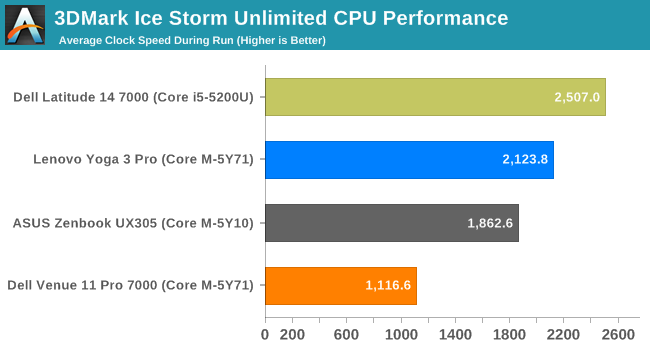
Looking at the average CPU speeds, the Yoga 3 Pro jumps way out in front. The Venue 11 Pro is quite far behind, but as you can see in the graphs, when the work was required, it did have thermal headroom available to turbo.
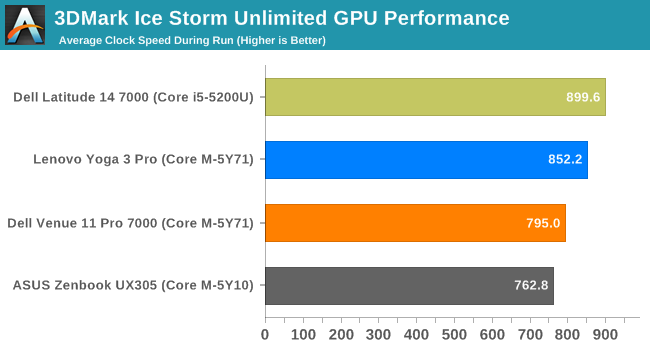
On the GPU front, the Yoga 3 Pro is almost at the same average as the Core i5 in this test, as both have the same base and turbo frequencies. The Venue 11 is only a bit behind, and the ASUS falls to third due to the 100 MHz frequency deficit that the 5Y10 has on the GPU compared to the 5Y71 processor.

On the SoC temperature side, none of the devices struggle with temperature on such a short test.
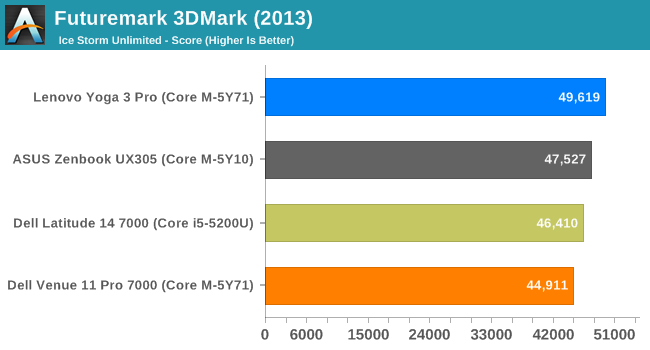
On such a short test, the Core M devices all do very well, and the fastest Core M model in the Yoga 3 Pro tops this GPU test. It is quite a bit in front of the rest of the devices, showing that with active cooling, it can still get a lot of work done in a short amount of time. Remember that the Core i5 Dell Latitude is the only device with single-channel memory, which hurts it most in the GPU tests and explains why it is below the Core M devices despite much higher average frequencies for both the CPU and GPU.


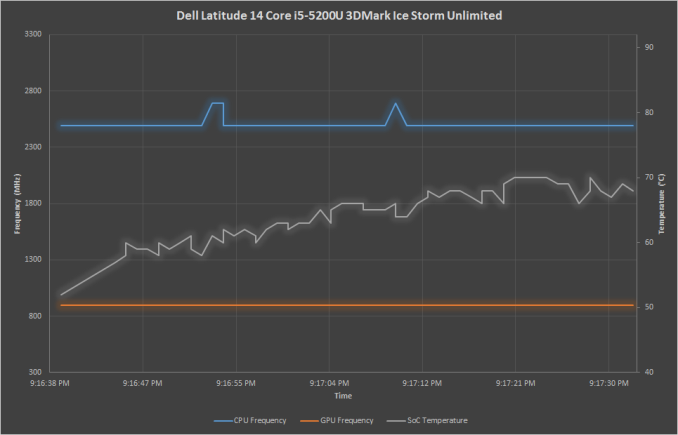
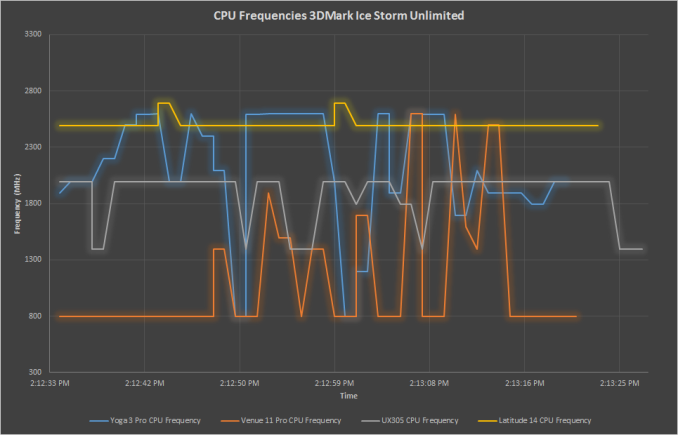
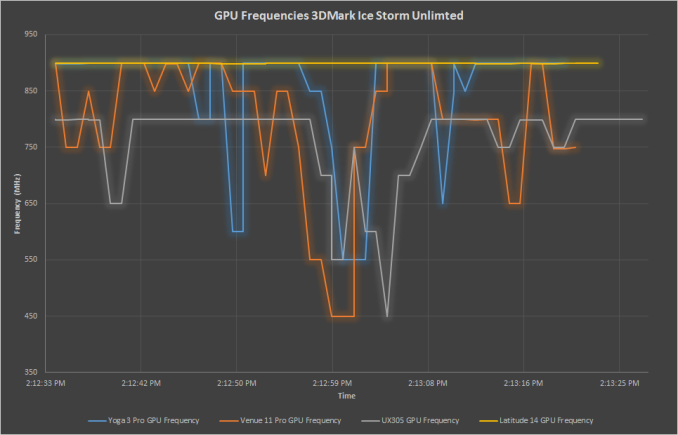









110 Comments
View All Comments
zodiacfml - Wednesday, April 8, 2015 - link
A long for this look at the performance Core M. Thanks. Like all nice, popular movies the end is pretty expected after a review from the Asus UX305. It's also good that the Dell is there to provide the scores for no limitation on cooling for long continuous loads.After all this, I don't see any problem. The performance of the Asus is pretty expected as well having a tradional notebook design which is fairly overkill for the SDP/TDP.
I was a PC overclocker many years ago and then realized that underclocking and overclocking at the same time would be ideal. I believe the race to wider CPU dynamic range has become mainstream.
dragonsqrrl - Wednesday, April 8, 2015 - link
"Each model comes with 4MB of L2 cache" On the first page.Shouldn't that be L3 cache?
dananski - Wednesday, April 8, 2015 - link
I love how the Asus tries to draw a piano keyboard in the PCMark 8 Creative graph. Very creative of it.DryAir - Wednesday, April 8, 2015 - link
The temperature x time graphs are all messed up. The lines goes "back" on many ocasions, indicating 2 different temperatures on a same time stamp. You should check the settings on whatever program you are using to generate these graphics.be_prime - Wednesday, April 8, 2015 - link
I just signed up to comment on the same thing -- the graphs are so clearly distorted by some (no doubt well-intentioned) spline/smoothing that much (even most?) of the data we see here may be the product of a spline or interpolation process, and not represent a data measurement. Where the line goes "back", as DryAir pointed out, it implies time travel.That's a very big miss for a site that I've considered to be thoughtful and authoritative. The approach you took here presents false and interpolated data and obscures the quality of your research. Don't let the goal of an attractive graph ruin the whole point of the graph: showing the data.
These graphs are obviously impossible due to the spline/interpolation used, and should be replaced by a scatter plot or normal line graph.
Brett Howse - Wednesday, April 8, 2015 - link
As I mentioned on the Devices and Test page, sometimes the devices were very heavily loaded and they were not able to log consistently. Sometimes they would log twice in the same second, but with slightly different values. One log would be time 0:00:01:05, and another would log 0:00:01:95 (for instance), but both would be truncated to the same second. Unfortunately that's just the limit of the software, since it only logs time to the nearest second. A second can be a lot of time for a CPU.be_prime - Thursday, April 9, 2015 - link
That's fine because those data points represent measurements.The problem here is you've used interpolated splines/curves which, in this case, actually show impossible or false information: the curve leaning "left" implies that the x-axis (time) is decreasing: that's time travel, and it'd be a bigger story than the Core M for sure, right?
Also recognize that if you're gathering data points, but drawing a line, you're always implicitly creating an interpolation between those points (at least in viewers minds). Usually, it doesn't matter so much. Here, the resulting lines are false, and I think Anandtech is a better publication than that.
As it stands, the interpolation/smoothing on your graphs implies time travel. Respectfully: please correct this (or, patent the relevant technology and profit!). If you're going to make your graphs look "pretty" and don't care if they're correct, I can't trust your results.
DryAir - Friday, April 10, 2015 - link
Sarcastic time travel jokes aside, I agree that you should change it somehow. Perhaps just change the data points to be connected to a straith line, instead of a smoothed one. Right now its looking very amateuristic, not matching an otherwise great and highly technical review.Brett Howse - Friday, April 10, 2015 - link
Ice Storm was the worst offender so I've re-generated the graphs with straight lines. There just was not enough data points on that one because it was so short.gw74 - Wednesday, April 8, 2015 - link
I am furious that OEMs are using Core M in ultrabooks. It is the solution to a problem which does not exist. The Samsung Series 9 / ATIV 9 Plus use full fat i5 and i7 ULVs and the 2 tiny fans hardly ever come on. when they do, they sound like mice whispering. and huge battery life.Core M is not progress when used in the ultrabook factor. it is a step backwards and a ripoff.